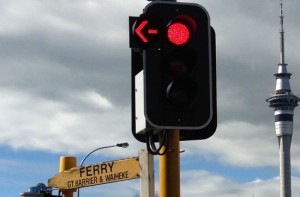
You’ve probably heard of the 2-second rule. It’s a rule that light vehicle drivers can use in dry weather on good road surfaces to maintain a reasonably safe following distance to a vehicle in front. You simply count two seconds…
Wearing safety belts The driver is responsible for ensuring all passengers under 15 years of age wear seat belts. Passengers 15 years of age and over are responsible for putting seat belts on themselves. If you are riding a motorbike,…
Let’s look at a number of examples of giving way which can help you determine what to do at many kinds of intersections in New Zealand (and around the world). If you’ve been confused about the rules before, these simple…

Our traffic lights conform to international standards in terms of their colour, but we have slightly different phasing than some countries. Red lights A red light always means stop. You must wait until the green light shows before you can…
This is a convenient list of speed limits in New Zealand for all types of vehicles. For cars and motorbikes the open road speed limit is 100km/h if the conditions are good. Other vehicles have restricted limits, though. The default…
Work time restrictions are placed on heavy vehicle drivers because driver fatigue is a leading cause of fatal crashes. Commercial drivers are particularly at risk, especially when they drive during shift-work. To keep drivers accountable details are stored in a…
Vehicle weight definitions The tare weight is the weight of the vehicle itself, not including any load. Gross weight or gross vehicle mass is the combined weight of a vehicle and its load, accessories, equipment and passengers. Before an overweight vehicle…
To help drivers see where a road is going ahead, both in the day and at night, roads are often installed with markers on the left and right verges, road studs (also called cat’s eyes or reflective raised pavement markers),…
In this article we’ll discuss how competent drivers avoid accidents, and tell you your obligations if you do have an accident. Until computers control all our vehicles, we will continue to have crashes because drivers are only human. Unfortunately humans…
Here are all the temporary warning signs you are likely to see on New Zealand’s roads. They are primarily deep orange and/or white with black writing. Remember to check out our other sign guides starting here. Road workers will be…